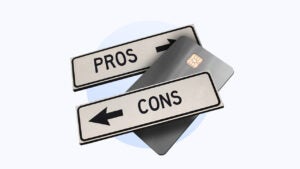Paperless credit card statements: How it works, pros and cons

Our writers and editors used an in-house natural language generation platform to assist with portions of this article, allowing them to focus on adding information that is uniquely helpful. The article was reviewed, fact-checked and edited by our editorial staff prior to publication.
Key takeaways
- Enrolling in paperless credit card statements can lead to easier management, faster access and reduced environmental impact.
- Credit card companies have implemented strict security measures to protect customer data in paperless billing.
- Effective management of e-statements involves organization, regular reviews and secure storage.
- To avoid missed payments, it is important to keep contact information up-to-date, use strong security measures, and set reminders for payments.
If your wallet includes a credit card, chances are you’re familiar with the concept of a billing statement. Paper-based card statements outline how much you’ve spent, what your balance is on your card and other information, like the minimum payment required and the due date.
Most cards also offer e-statements, helping you to keep track of your card statements while cutting down on clutter and the environmental stress of paper statements. Here’s how paperless statements work, including the benefits and potential drawbacks to be aware of.
How paperless billing works with credit cards
Paperless credit card statements allow you to receive your monthly card statement online, instead waiting for a physical copy through the mail. When you opt for paperless statements, your credit card issuer emails you a notification when your statement is ready to view. You can then log in to your online banking or mobile banking app to view, print or download your statement for filing.
Benefits of going paperless
Opting for paperless credit card statements comes with several notable benefits:
- Environmentally friendly. Reducing the usage of paper helps to save trees and conserve the environment.
- Easier to manage. Statements are stored in one place, eliminating the clutter of physical papers.
- Faster access. Your statement is available as soon as it’s processed by your provider, letting you access it more quickly than waiting for mail delivery.
- Protect your information. Paperless statements can reduce the chances of identity theft, eliminating the risk of mail theft, and reducing the chances of ID theft.
Drawbacks of paperless billing
While paperless billing offers convenience and contributes to environmental sustainability, it’s not without its potential drawbacks.
- Can lead to missed payments. If you’re used to the physical reminder of a mailed monthly statement, transitioning to paperless could result in missed payments initially.
- Requires internet access. If you’re not tech-savvy or don’t have reliable internet, accessing e-statements can be challenging.
- Risk of overlooked charges. The convenience of automatic payments could lead to missed billing errors or gradual price increases.
- Risk of digital clutter. Without proper organization, digital statements can become just as cluttered as physical statements.
How to manage your e-statements effectively
Effectively managing your e-statements involves a combination of organization, regular review and secure storage. It’s also essential to keep your contact information up-to-date to ensure you receive all necessary communications from your credit card issuer.
Here are steps to filing and backing up your e-statements for easy access:
- Organize your folders. Create a clear, hierarchical system for your e-statements, such as a main folder for financial documents, subdivided by year and type of statement.
- Name your files consistently. Develop a consistent and descriptive naming convention, including the date, company name and type of document.
- File documents immediately. As soon as you receive an e-statement, move it to an appropriate folder to stay organized.
- Regularly clean your files. Periodically review and remove or archive unneeded e-statements to avoid clutter.
- Back up your files. Regularly back up your e-statements using an external hard drive, cloud storage service or other backup solutions to safeguard against data loss.
Tips to enhance e-statement security
Securing your e-statements and online banking activities involves a combination of strong password management, two-factor authentication, cautious use of public Wi-Fi and vigilant monitoring for phishing scams.
- Choose strong and unique passwords. Update your passwords regularly and avoid using easily guessable information.
- Enable multi-factor authentication. Add an extra layer of protection during login with multi-factor authentication or two-factor authentication.
- Don’t use public Wi-Fi for banking. When not at home, use a virtual private network (VPN) for a safer connection to access your statements.
- Sign up for banking alerts. Receive notifications of any unusual or suspicious account activity.
- Stay alert to phishing scams. Verify the authenticity of emails or texts before responding or clicking links.
- Use trustworthy financial apps. Download banking apps from your bank’s website or verified sources like the App Store or Google Play.
The bottom line
If you’re paper averse, you can sign up for paperless billing statements for your credit card. With e-statements, you receive notification when your bill is ready with a link to your online banking platform or banking app. From there, you can view your charges, pay your bill and even download your statement for printing or filing. Set up alerts to make sure you don’t miss a payment, and consistently organize your digital statements for easy access if you need them.








